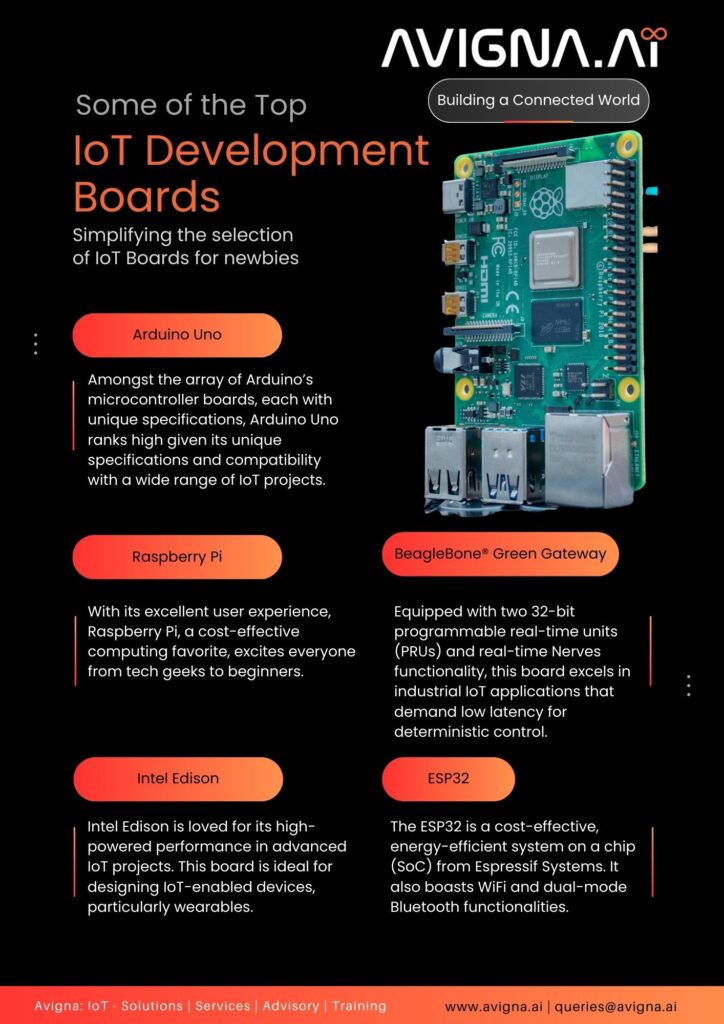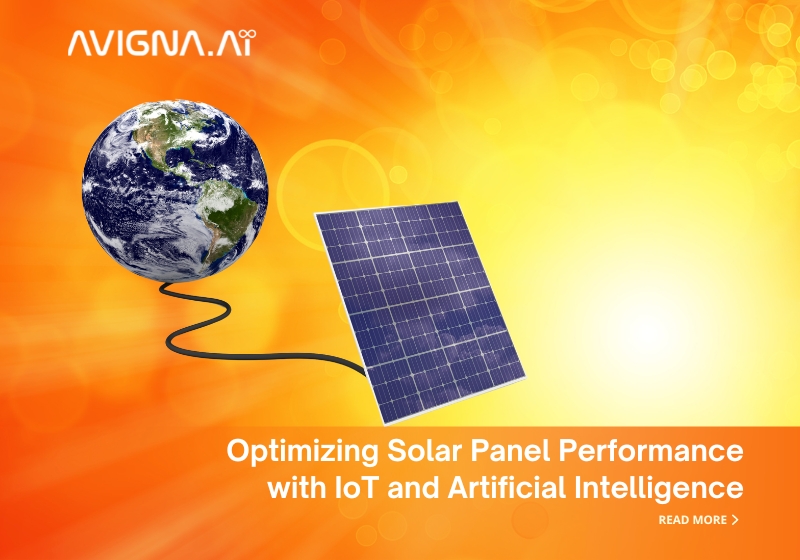The realm of the Internet of Things (IoT) is constantly advancing and strengthening cloud capabilities. Studies suggest that as of 2022, there’s an impressive count of over 12.2 billion IoT devices deployed globally. Reports also project that the growth could soar to $25.44 billion by 2030.
IoT’s benefits are extensive, influencing diverse areas, from home automation and agriculture to medical applications and supply chains. To the newbies in the IoT arena, selecting a suitable board can present a challenge. Below is a collection of ten top IoT development boards optimally designed for your inaugural IoT project to facilitate this choice.
Arduino Uno
Arduino provides an array of microcontroller boards, each with unique specifications, suitable for a range of IoT projects. Amongst them, Arduino Uno ranks high on the list of IoT development boards.
Both novices and experts appreciate it.
The board works on the ATmega328P, with 14 digital input/output pins and six analog inputs. Despite having only 32 KB of Flash memory, it handles complex logic.
Community support for Arduino is robust. This thriving ecosystem spans sensors, actuators, and libraries. Arduino’s board layout influences many other prototyping environments. Its open-source IDE is user-friendly, featuring a syntax based on ‘C’. Arduino Uno R3 is an excellent choice for those exploring electronics and IoT.
Raspberry Pi
Raspberry Pi, a cost-effective computing favorite, excites everyone from tech geeks to beginners. The latest Raspberry Pi 3 tears down walls with inbuilt WiFi and Bluetooth. This pocket dynamo features a Broadcom BCM2837 SoC, a 1.2 GHz 64-bit quad-core ARM Cortex-A53 processor, and 1GB RAM.
Raspberry Pi uses a customized Debian Linux called Raspbian. It offers an excellent user experience. Developers and hackers enjoy its versatility.
With four USB ports and 40 GPIO pins, the Raspberry Pi can connect many peripherals and accessories. It supports Node.js, LAMP stack, Java, and Python.
Intel Edison
Intel Edison ranks top among microcontroller boards for its high-powered performance in advanced IoT projects. This System-on-Chip (SoC) module features an Intel® Atom™ 500MHz dual-core CPU and an Intel® Quark™ 100MHz microcontroller. This board is ideal for designing IoT-enabled devices, particularly wearables.
Its unique design supports advanced IoT applications and boasts certification from IBM, AWS, and Microsoft for cloud connectivity. The dual-core Intel Quark x86 CPU runs at 400 MHz. It supports both Bluetooth and WiFi.
Intel Edison has connectivity features such as:
- Integrated WiFi
- Bluetooth support
- Dual-core Intel Atom CPU
- Intel Quark100MHz microcontrollers.
The board provides 20 digital input/output pins, including 6 PWM output pins, matching Arduino Uno’s compatibility. The board houses 1GB RAM and 4GB flash memory and supports UART, SPI, and I2C communication, powered via USB with SD card support.
BeagleBone® Green Gateway
The BeagleBone Green Gateway is a collaborative effort by BeagleBoard and Seeed Studio. Equipped with two 32-bit programmable real-time units (PRUs) and real-time Nerves functionality, it excels in industrial IoT applications that demand low latency for deterministic control.
It can boot Linux in under 10 seconds and provides ports for Seeedstudio Grove sensors for accelerated integration.
Connectivity features include:
- Ethernet
- WiFi and Bluetooth
- AM3358 ARM® Cortex-A8 processor that powers the board.
The BeagleBone Green Gateway boasts 512MB DDR3 memory and 92 GPIOs, supporting I2C and UART communication. It offers 4GB eMMC and 4KB EEPROM storage, drawing power from a MicroUSB or 5V DC input. It is optimized as an IoT development board to deliver power and performance for various applications.
Also Read: Benefits of IoT for OEM Industry
Arduino Nano 33
Arduino Nano 33 is a powerful dual-processor board. It is designed for experimenting with Internet of Things (IoT) applications, especially where the size and shape are essential.
It works seamlessly with the Arduino IoT Cloud. This platform allows developers to create IoT applications effortlessly, even if they don’t have extensive experience in the field.
This IoT development board is a cost-effective choice for developers. It offers Bluetooth and WiFi connectivity, which adds to its popularity. Equipped with an ARM Cortex-M0 32-bit SAMD21 processor, it ensures efficient performance.
This board boasts 14 digital I/O pins and eight analog input pins. It supports 12-bit ADC/PWM and 10-bit DAC resolutions and synchronous communication.
It offers excellent performance with a Nordic nrf52840 chip and a clock speed of 64 MHz. It also features a Microchip® ECC608 for secure certificate and pre-shared key storage. Development is made simpler with the support of Arduino and Nordic software.
The Arduino Nano 33 IoT board contains a 6-axis Inertial Measurement Unit (IMU). It has powerful sensors that can detect:
- Humidity
- Temperature
- Barometric pressure
- Sound
- Proximity
- Luminosity
Giant Board
The Giant Board is a pioneering single-board computer shaped in the Adafruit Feather style. It is preloaded with Debian Linux, providing developers immediate access to an extensive library selection. The board features a Microchip SAMA5D2 ARM Cortex-A5 Processor and includes USB compatibility.
This device operates at 500 MHz with 128MB RAM and boasts six 12-bit ADC channels. It communicates through SPI, UART, and I2C. You can power it using a USB or a suitable LiPo battery.

ESP32
The ESP32 is a cost-effective, energy-efficient system on a chip (SoC) from Espressif Systems. It also boasts WiFi and dual-mode Bluetooth functionalities.
This microcontroller board’s notable features include a dual or single-core Tensilica Xtensa LX6 microprocessor with a maximum 240 MHz clock rate. It is specifically designed for mobile devices, wearable tech, and IoT applications.
The ESP32 seamlessly integrates with:
- Antenna switches
- RF baluns
- Power amplifiers
- Noise-reduction receivers
- Filters
- Power management modules
- Touch-sensitive pins
- in-built hall and temperature sensors.
Its popularity among microcontroller boards underscores its robust IoT technology foundation.
Onion Omega 2
The Onion Omega 2 is a compact, cost-effective IoT development board ideal for any DIY venture. It is a fully functional computer equipped with a Linux-based system making it cross-compatible with an extensive array of programming languages and libraries.
The microcontroller board’s connectivity options include 2G/3G, WiFi, Bluetooth, and Ethernet. An MT7688 SoC powers it with a 580 MHZ CPU. Its small footprint and modular architecture make it versatile for numerous applications.
This IoT development board has 128GB of RAM, 32GB of Flash, and 18 GPIOs, along with onboard flash storage. It supports UART, SPI, and I2C communication. Although there is no analog input, you can connect it by using an I2C converter or an extension board.
SeeedStudio NPi i.MX6ULL Dev Board
SeeedStudio offers one of the best energy-efficient microcontroller boards. Built with the i.MX6 application processor specially engineered to manage multimedia tasks such as video, voice, audio, and touch, this versatile board provides full support for HD 1080p video conferencing, encoding/decoding, and high-definition 3D video playback.
Some other additional features include:
- Ethernet connection
- 24-bit RGB display interface
- Raspberry Pi expansion header
- 512MB DDR3L RAM
- An additional 40-position GPIO
- I2C communication support
- A USB port
- 5V barrel jack
Jetson Nano
The NVIDIA Jetson Nano is your go-to powerhouse for businesses diving into AI or robotics. It’s a multitasker, running several neural network apps at once. It is perfect for bulk-volume tasks like:
- Object detection
- Segmentation
- Speech processing
Moreover, NVIDIA levels up the game with their open-source project – Jetson Inference. It’s a treasure trove for developers dabbling in machine learning, showcasing crucial techniques.
The Jetson Nano is no slouch on the connectivity front, either. It’s armed with Gigabit Ethernet and can play nice with WiFi via an adapter.
It’s a true workhorse with:
- Hefty 2GB RAM
- Quad-core ARM humming at 1.53 GHZ
- 128-core NVIDIA GPU based on mighty Maxwell architecture.
It flaunts 40 GPIOs and is fluent in UART, SPI, and I2C communication. JetPack development kit allows you to work on Linux and access frameworks and libraries such as TensorRT, VisionWorks, CUDA, and OpenCV. Bonus, it features a 1/3? AR0330 CMOS Image sensor with 2.2 µm pixels for superior image capture.
Identifying Key Features in an IoT Board
Choosing an IoT development board requires considering several crucial features. The board’s capabilities should align with your project’s needs, whether it involves data collection, connectivity, or real-time response. Here are the essential features to look for when selecting an IoT board:
Exceptional Connectivity
Your chosen IoT board should excel in this area because IoT is all about interconnectivity. Evaluate whether the board has built-in WiFi, Bluetooth functionality, and Ethernet support. These capabilities are critical for ensuring your IoT applications can interact effectively with other devices and the internet.
Scalability
Adding more functionalities to your IoT board is crucial for future-proofing your investment. As IoT technology advances rapidly, your board should be able to adapt and incorporate additional features to stay relevant.
Support for Peripherals
Your IoT board should support peripherals, including ports like HDMI and USB, and pin-outs for pulse width modulation (PWM) devices such as servo motors and dimmable lights. This support will allow your IoT device to interface with other devices and systems.
Processing Power
Whether it’s a microcontroller, CPU, CPLD, or FPGA, your board should have sufficient processing power to handle your IoT application’s needs. Ensure the manufacturer provides the necessary IDE for programming the IoT-enabled devices.
Adequate Board Memory
Board memory is another crucial feature. For storing vast volumes of data, your board should have built-in Flash memory and the ability to connect a MicroSD or MiniSD to expand data storage as needed.
Wireless Capabilities
Ensure your board supports wireless communication protocols such as WiFi, Bluetooth, and Zigbee. Also, check if the board communicates through SPI, UART, and GPIO to understand how it will interact with other devices.
Wrapping It Up
IoT development boards are the cornerstone of smart device creation. They provide the hardware and firmware to prototype and produce cutting-edge IoT applications. By understanding the types of boards available and their key features, you can select the right board for your project and unlock the full potential of IoT technology.
Whether you’re an experienced IoT developer or just starting in the field, understanding the landscape of IoT development boards is crucial. From microcontroller-based boards to robust single-board computers, there’s a board out there to suit your IoT project’s specific needs.
Avigna is a fast-growing IoT implementation partner for Manufacturing Companies. Connect with us at queries@avigna.ai to learn how we assist you in your IoT implementation.



